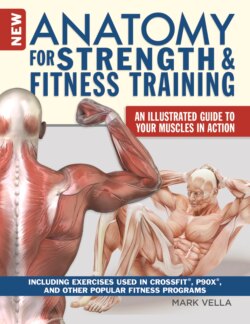Читать книгу New Anatomy for Strength & Fitness Training - Mark Vella - Страница 12
На сайте Литреса книга снята с продажи.
ОглавлениеHow This Book Works
This book is a unique and exciting guide, reference, and graphic education tool in exercise and functionally oriented training anatomy. It is a visual and literal analysis of common exercises, as well as an exercise guidebook on how to do key exercises properly. It helps you to better understand the anatomy and the science of movement, known as structural kinesiology. Whether you are interested in understanding your own body and exercise program, or whether you are a coach, trainer, or teacher delving deeper into exercise science and anatomy, this book will give you many hours of fascination as well as a deep reserve of knowledge and personal value.
The book is divided into two distinct parts: Part 1, the primer, and Part 2, the exercises.
PART 1: CONDITIONING PRIMER introduces the gross anatomy of the musculoskeletal system and its movement and shares with you the relevant guiding concepts and training principles that can be used to develop and progress safely and effectively in training programs. It compares some of the new training options out there and offers some sample exercise workouts. It ends with an overall scaling map you can use to program your own workout or to scale an existing one up or down.
PART 2: EXERCISES comprises more than 100 exercises organized in 10 categories, including sections on stabilization, compound, plyometric and explosive, and endurance training exercises, as well as several body part sections, including chest, legs, hips, back, shoulders, and arms. Each of the 10 sections in Part 2 starts with a basic introduction that focuses on the body part or type of training. And each standalone exercise is a self-contained guide—you do not need to read the book in sequence! Each exercise includes several main features. The main exercise is defined and given some background at the top of the page. There is a starting position, description, and training tips section for each exercise, essentially comprising the “how-to” instructions for the exercise. There is a visual and technical muscle analysis of the main muscles being used, and you’ll also find a color drawing accompanied by smaller start and finish position drawings.
NEW EXERCISE GRADING SYSTEM!
We have adopted a new color system in this book for quick and clear visual reference. Green refers to lower-intensity training and exercises suited to beginners/less-fit individuals. Orange indicates intermediate-level intensities. Red indicates advanced exercise for well-conditioned participants. You’ll see this in the color indicators on the page corners and in the scaling guide (see here). Note that the colors are meant as a guide, not absolute gospel: exercises can be varied greatly just by changing speed, repetitions, resistance, and rest periods.
NOTE: There are more than 600 muscles and 200 bones in the adult human body. For the purpose of effectiveness and practicality, an emphasis is placed on around 70 main muscles involved in movement and stabilization. Many of the smaller muscles, the deep, small muscles of the spine, and most muscles of the hands and feet are not given specific attention. If they were, it might take several pages to analyze just one exercise and movement!
Waiver and Caution
This book is a useful tool, but it does not replace the expertise and wisdom of professionals who understand the art and science of conditioning, matched with the character that can support you, motivate you, and hold you back when you begin to overdo it. Seek them out and work with them.
DISCLAIMER
Many of the exercises in this book have a degree of risk of injury if done without adequate instruction and supervision. We recommend that you get a proper fitness assessment before undertaking any of the exercises, and that you seek qualified instruction if you are a total beginner. This book does not constitute medical advice, and the author and publisher cannot be held liable for any loss, injury, or inconvenience sustained by anyone using this book or the information contained in it.
